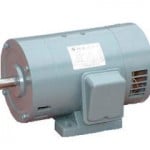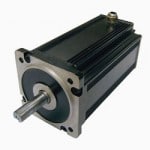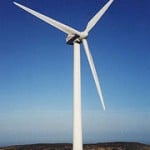
Induction generators are squirrel caged machines responsible for transforming the kinetic energy of the wind into electrical energy. Three-phase induction machines have three electrical windings embedded into its stator so are well suited for wind power and even hydroelectric power generation. Induction machines, also known as asynchronous machines, rotate above synchronous speed when used as an electrical generator producing 3-phase AC electricity. As an induction generator can be synchronised directly with the main utility grid supply, it produces electricity at the same frequency and voltage.

Synchronous generators require an external DC power supply to be applied to the main rotor windings by means of slip-rings and carbon brushes in order to produce a constant magnetic field basically making the main rotating part (the rotor) of a synchronous machine into a large electromagnet. The rotor is rotated by the external wind turbine blades connected to it creating a rotating magnetic field within the generators body. Electrical copper windings are incased into the stationary part (the stator) of the synchronous generators body and are the main windings where the voltage is induced. So by varying the amount of rotor field current, it is possible to vary the staors output voltage.

Permanent magnet DC generators, or PMDC machines, can be used as either conventional motors or as DC wind turbine generators as constructionally there is no basic difference between the two. In fact, the same PMDC machine may be driven electrically as a motor to move a mechanical load, or it may be driven mechanically as a simple generator to generate an output voltage. This then makes the permanent magnet DC generator (PMDC generator) ideal for use as a simple wind turbine generator. The two basic connections for a permanent magnet DC machine are shunt wound and series wound, with each type of DC generator having its own set of advantages and disadvantages.

Wind turbine generators for wind power applications can vary from a small DC voltage dynamo to large AC mains rated synchronous machines. The type of electrical machine used to generate the electrical energy depends alot on the size, complexity and dynamics of the wind power as small machines can operate suscessfully in small-scale home or garden based generating applications with steady state wind conditions, whereas larger machines may be required to supply several households in windy mountainous areas or offshore conditions were the voltage and frequency of generated electricity may need to be synchronised before it can be transferred and used by the grid.

Wind turbine design for wind power applications involves understanding the basic concepts about aerodynamics, mechanics, structural theory as well as the flight mechanics of fixed-wing and rotary-wing blades. People think that the design of a wind turbine is straightforward, erect a pole or structure, add a generator to the top, and connect some blades to it. But the cost of generating electrical power from wind energy is linked to its design, efficiency and reliability of the turbine.